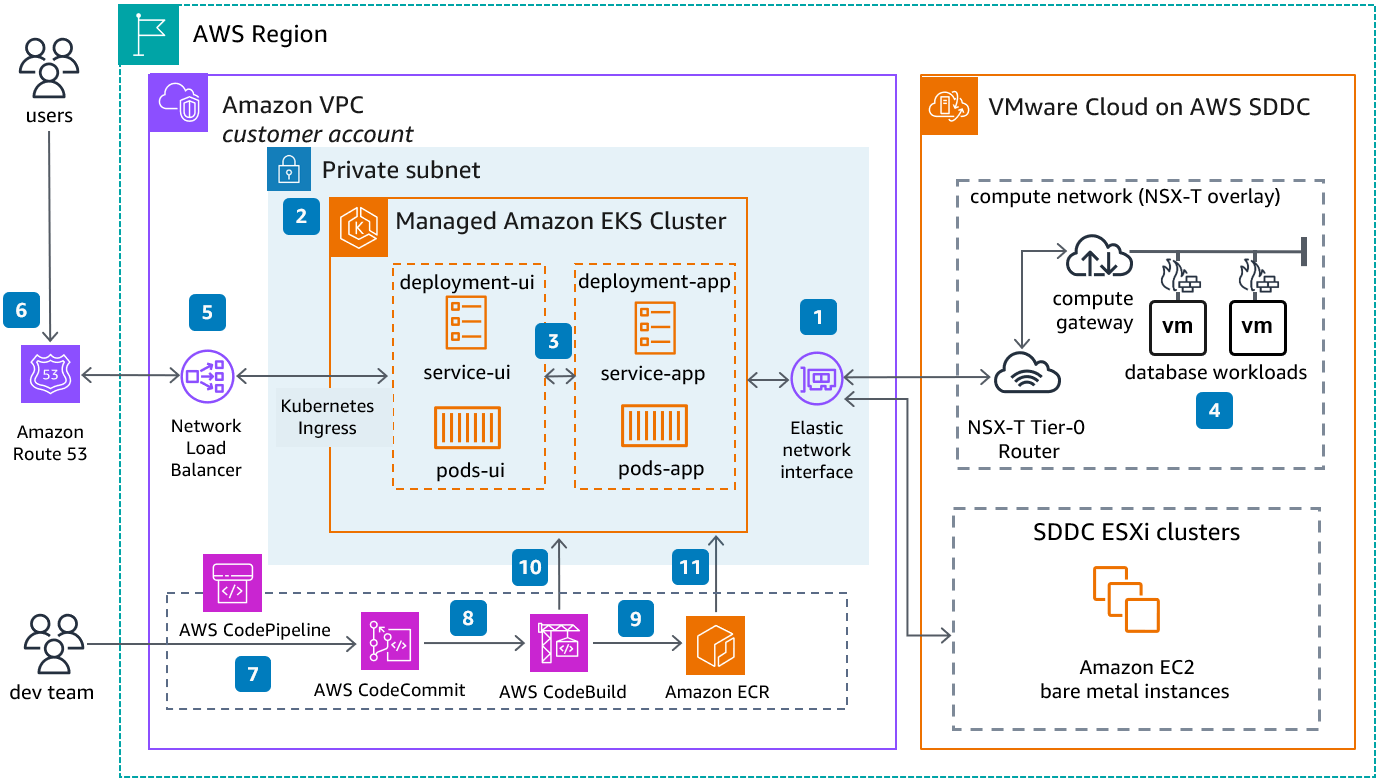Modernize Applications with Microservices Using Amazon EKS
Publication date: July 24, 2023 (Diagram history)
This architecture enables you to integrate Amazon Elastic Kubernetes Service (Amazon EKS) with VMware Cloud on AWS. Use AWS DevOps tools to accelerate application modernization.
Modernize Applications with Microservices Using Amazon EKS Diagram

-
The Elastic Network Interface is automatically attached to the Amazon Elastic Compute Cloud (Amazon EC2) bare metal (ESXi) hosts in VMware Cloud on AWS during the software-defined data center (SDDC) provisioning.
-
Provision fully managed Amazon Elastic Kubernetes Service (Amazon EKS) clusters for different environments (dev/test/production).
-
Use tools such as AWS App2Container (App2Container) to accelerate refactoring/rearchitecting applications into containerized microservices. Use Amazon EKS to manage and automate the testing and deployment of container workloads.
-
Transform and containerize legacy systems to modern applications with minimal disruptions. The existing database tier can keep running on VMware Cloud on AWS to avoid the complexity and delay of database migrations.
-
Network Load Balancer integrates with the Kubernetes Ingress Controller, providing a secure and consistent approach for exposing applications.
-
Amazon Route 53 resolves incoming requests to Network Load Balancer in the primary AWS Region.
-
The dev team commits code to an AWS CodeCommit repository, which initiates AWS CodePipeline to start processing the code changes through the pipeline.
-
AWS CodeBuild packages the code changes and dependencies and builds a Docker image.
-
The new Docker image is pushed to Amazon Elastic Container Registry (Amazon ECR).
-
CodeBuild uses a Kubectl command line tool to invoke Kubernetes API and update the image tag for the microservice deployment.
-
Kubernetes performs a rolling update of the pods in the application deployment according to the new docker image specified in Amazon ECR.
Download editable diagram
To customize this reference architecture diagram based on your business needs, download the ZIP file which contains an editable PowerPoint.
Create a free AWS account
Sign up for an AWS account. New accounts include 12 months of AWS Free Tier
Further reading
For additional information, refer to
Contributors
Contributors to this reference architecture diagram include:
-
Sheng Chen, Senior Migration Solutions Architect, VMware Cloud on AWS
-
Jyothi Goudar, Manager Partner Solutions Architect, Amazon Web Services
Diagram history
To be notified about updates to this reference architecture diagram, subscribe to the RSS feed.
| Change | Description | Date |
|---|---|---|
Diagram update | Diagram reviewed and updated for freshness | July 24, 2023 |
Initial publication | Reference architecture diagram first published. | April 12, 2021 |
Note
To subscribe to RSS updates, you must have an RSS plugin enabled for the browser you are using.
